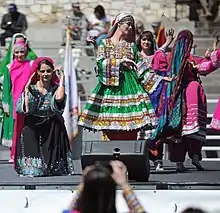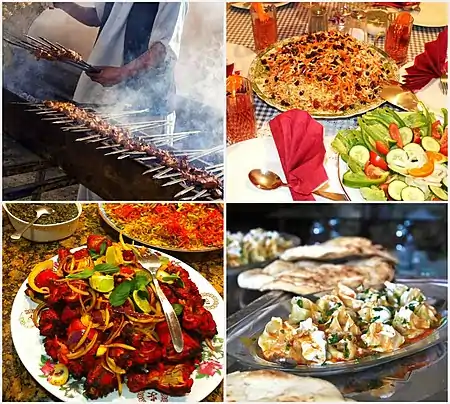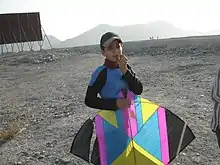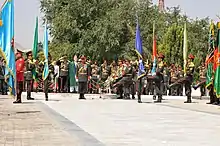.jpg.webp)
| Part of a series on the |
| Culture of Afghanistan |
|---|
 |
| History |
| People |
| Languages |
| Mythology |
| Cuisine |
| Festivals |
| Religion |
| Sport |
| History of Afghanistan |
|---|
 |
| Timeline |
|
The culture of Afghanistan[1][2] has persisted for over three millennia, tracing record to at least the time of the Achaemenid Empire in 500 BCE,[3] and encompasses the cultural diversity of the nation. Afghanistan's culture is historically strongly connected to nearby Persia, including the same religion, as the people of both countries have lived together for thousands of years. Its location at the crossroads of Central, South and Western Asia historically made it a hub of diversity, dubbed by one historian as the "roundabout of the ancient world".[4]
Afghanistan is a mostly tribal society with different regions of the country having their own subculture. Despite this, nearly all Afghans follow Islamic traditions, celebrate the same holidays, dress the same, consume the same food, listen to the same music and are multi-lingual to a certain extent. Its culture is strongly tied with elements of Turko-Persian and Indo-Persian cultures,[5][6] which can be seen in the likes of language, cuisine or classical music.
Afghan culture is increasingly becoming a dynamic realm of academic study in scholarly terms.[7] In more recent history, Afghan culture has been threatened and fragmented due to the prolonged conflict in the country.[8][9]
History
Music and dance

Traditionally, only men have been involved in theater acting. Recently, in theater arts, women have begun to take center stage.[10]
Since the 1980s, the nation has witnessed several wars so music has been suppressed and recording for outsiders minimal. During the 1990s, the Taliban government banned instrumental music and much public music-making. Many musicians and singers continued to play their trade in the cities of other countries. Pakistani cities such as Peshawar, Karachi and Islamabad are important centers for the distribution of Afghan music. Kabul has long been the regional cultural capital, butq outsiders have tended to focus on the cities of Herat and Mazar-e-Sharif with its Qataghani style. Lyrics across the country are typically in both Dari-Persian and Pashto, Uzbeki, Hazaragi, Hindi, and western style songs and music are also very popular in Afghanistan.[11]

Afghans enjoy music by playing many types of instruments. They also enjoy performing the Attan, which is considered the national dance of Afghanistan. What is typically heard in the country are folk songs or ballads. Many of the songs are known by almost everyone and have been around for many years. The main traditional Afghan music instruments include:
Language and literature
Dari and Pashto are both the official languages of Afghanistan,[2] although Dari (Afghan Persian) serves as the lingua franca for the majority. People in the northern and central areas of the country usually speak Persian/Dari, while those living in the south and east speak Pashto. Afghans living in the western regions of Afghanistan speak both Dari and Pashto. Most citizens are fluent in both languages, especially those living in major cities where the population is multi-ethnic. Several other languages are spoken in their own regions, which includes Uzbek, Turkmen and Balochi.[2] English is gradually becoming popular among the young generation. There are smaller number of Afghans who can understand Russian, mainly among the northern Tajik, Uzbek and Turkmen groups.
Poetry
Poetry in Afghanistan has long been a cultural tradition and passion. It is mainly in Persian/Dari and Pashto languages, although in modern times it is also becoming more recognized in Afghanistan's other languages. Classic Persian and Pashto poetry plays an important role in the Afghan culture. Poetry has always been one of the major educational pillars in the region, to the level that it has integrated itself into culture. Some notable poets include Khushal Khan Khattak, Rahman Baba, Massoud Nawabi, Nazo Tokhi, Ahmad Shah Durrani, and Ghulam Muhammad Tarzi.[13] Some of the famous Persian-language poets and authors from the 10th to 15th centuries are Rumi, Rabi'a Balkhi, Khwaja Abdullah Ansari, Jami, Alisher Navoi, Sanai, Abu Mansur Daqiqi, Farrukhi Sistani, Unsuri, and Anvari. Contemporary Persian language poets and writers include Khalilullah Khalili[14] and Sufi Ashqari.[15]
Proverbs
Afghans prize wit and cleverness in speech. "Zarbul Masalha" (pronounced zar-bull mah-sal-HAA) means "proverbs" in Dari, and these zarbul masalha deeply reflect Afghan culture. U.S. Navy Captain Edward Zellem pioneered the use of Afghan proverbs as a positive relationship-building tool during the war in Afghanistan, and in 2012 he published two bilingual collections of Afghan proverbs in Dari and English.[16][17]
Naming customs and honorifics
Pet keeping
.jpg.webp)
Birds are the most popular animals that are kept as pets in Afghanistan. In Kabul there is a dedicated daily market selling a wide variety of birds from around the world.[18]
Architecture

The important architectural sites are found in Herat, Mazar-I-Sharif, Ghazni,[19] Qandahar, and Firuzkoh in Ghor Province. The region has made major contributions to the world's architecture. UNESCO has acknowledged Afghanistan's role by declaring the Minaret of Jam and the Buddhas of Bamiyan destroyed in 2001, World Heritage Sites.
Housing
Houses in rural Afghanistan historically have been made of mudbricks and mud, and have a series of rooms located around a private rectangular courtyard where women and children can move around without being seen by the public. In recent years, however, Afghans living in rural areas began building their homes using cement and bricks, similar as those built in the big cities.[20] In the north and west they are typically in fortified villages called qalahs ("fortresses"), whereas in the mountainous northern and eastern regions they differ, for example wooden multistoried dwellings in Nuristan.[21]
Married sons often share houses with their parents, but with separate quarters. Afghan houses contain a special room where men socialize with each other known as a hujra. In the major cities, many Afghans live in modern houses or apartments. The nomadic kuchi people live in large tents because they are constantly on the move from one part of the country to another.[22] The nomads of Turkic or Mongol origin in the north tend to live in yurts.[21]
 A mud brick house on a mountainside - a common sight in the hilly areas of the Afghan countryside
A mud brick house on a mountainside - a common sight in the hilly areas of the Afghan countryside Traditional brick homes common in the lower elevated regions in the north and west
Traditional brick homes common in the lower elevated regions in the north and west Nested homes in the forest region
Nested homes in the forest region A yurt, most likely in north-eastern Afghanistan
A yurt, most likely in north-eastern Afghanistan
Art, weaving, ceramics

The lands of Afghanistan have a long history of art, with the world's earliest known usage of oil painting found in cave murals in the country.[23][24] Afghan art includes Persian miniature style, with Kamaleddin Behzad of Herat being one of the most notable miniature artists of the Timurid and early Safavid periods. Since the 1900s, the nation began to use Western techniques in art. Abdul Ghafoor Breshna was a prominent Afghan painter and sketch artist from Kabul during the 20th century.
Afghanistan's art was originally almost entirely done by men, but recently women are entering the arts programs at Kabul University. Art is largely centered at the National Museum of Afghanistan, the National Gallery of Afghanistan and the National Archives of Afghanistan in Kabul. There are a number of art schools in the country. The Center for Contemporary Arts Afghanistan (CCAA) in Kabul provides young people to learn contemporary paintings.
Ceramics and pottery, of which many tend to be turquoise-colored, are produced in Afghanistan, most famously in the village of Istalif.[25]
The art of making carpets has been prominent for centuries. Afghanistan is known for making beautiful oriental rugs. The Afghan carpet has certain prints that make them unique to Afghanistan.
Afghanistan is known for its production of Afghan rugs, traditionally handwoven using a number of well-known and highly-prized patterns.
 Afghan items of pottery
Afghan items of pottery Items of pottery at a shop
Items of pottery at a shop Blue glass
Blue glass Afghan kilim
Afghan kilim Afghan embroidery pattern
Afghan embroidery pattern Afghan rugs and jewelry on sale, in the United States
Afghan rugs and jewelry on sale, in the United States
Cuisine
_Colonel_(COL)_Kevin_McDonnell_(background_center)%252C_Commander%252C_1ST_Battalion%252C_3rd_Special_Forces_Group_(SFG)_and_Afghanistan_National_Army_(ANA)_COL_Nahji_Bulla_(to_COL_McDonnells_right)_were_special_guest_at_a_lunch.jpg.webp)
Afghanistan has a wide varying landscape allowing for many different crops. Afghan cuisine is based on cereals like wheat, maize, barley and rice, which are the nation's chief crops. Afghans do not eat spicy food like the neighboring Pakistanis. Fresh and dried fruits is the most important part of Afghan diet. Afghanistan is well known for its fine fruits, especially pomegranates, grapes, and its extra-sweet jumbo-size melons.

- Popular Afghan dishes:
- Qabuli palao (traditional rice dish)
- Mosh Palao
- Shorba (Afghan soup)
- Do Pyaza
- Mantu (meat dumplings)
- Kofta (meatballs)
- Kichiri
- Rosh
- Chopan Kabab
- Afghani Kabab
- Mash Palao
- Qabuli Polao
- Qorma Sabzi
- Shola (sticky rice dish)
- Qoruti
- Eshkana
- Baunjan (cooked eggplant with potatoes and tomatoes)
- Bendee/Baumya (cooked okra with potatoes and tomatoes)
- Heeknusb (hummus)
- Aushak
- Aush (hand made noodles)
- Baghlava (baklava)
- Bolani (Afghan flat bread or crêpes)
- Chapli Kabab
- Shor-Nakhod (chick peas with special toppings)
- Naan (Afghan bread)
- Popular Afghan desserts:
- Gosh Feel (pastry)
- Halwa
- Shir Berinj (rice pudding)
- Ferni
- Kadu Bouranee (sweet pumpkins)
- Jelabi
- Maleeda or Khajoor
- Spice Rub
Dress and attire
Afghan traditional dress typically covers the entire body with a loose top and a form of head covering. The dresses are very colorful, especially women's.[26][27]
 Traditional tribal women's clothing
Traditional tribal women's clothing Traditional tribal men's clothing
Traditional tribal men's clothing Handmade dolls of traditional women's clothing at a fair
Handmade dolls of traditional women's clothing at a fair
Sport
.jpg.webp)
The sports in Afghanistan are organized by the Afghan Sports Federation, which promotes football, cricket, basketball, volleyball, golf, handball, boxing, taekwondo, track and field, bowling, skating[28] and several others.[29]
Football remains to be the most popular sport across Afghanistan.The Afghanistan national football team was founded in 1922, joined FIFA in 1948 and the Asian Football Confederation (AFC) in 1954. Although it did not play in any international games from 1984 to 2003 due to the war, it is now striving and hoping to make it to FIFA. The Afghanistan women's national football team was formed in 2007. The Ghazi Stadium, which was built during the reign of King Amanullah Khan, was once used for a venue for public executions by the Taliban government. The stadium is currently used mostly for football matches between teams from different provinces of the country as well as neighboring countries. Basketball has existed in Afghanistan since at least the 1970s, and is slowly becoming popular again. It is played by both Afghan men and women. Additionally, Afghans in the north of the country enjoy the sport of buzkashi.
Cricket has become popular in recent years in Afghanistan. The Afghanistan national cricket team, which was formed in 1996 during Taliban regime, has held matches against all other international cricket teams since 2001. The Afghan team rapidly rose through the World Cricket League since early 2008. It participated in the 2009 ICC World Cup Qualifier, 2010 ICC World Cricket League Division One, and 2010 ICC World Twenty20 where they played India and South Africa. The team won four times in a row, the ACC Twenty20 Cup in 2007, 2009, 2011, and 2013. It played against top ranking teams in the 2012 ICC Under-19 Cricket World Cup and the 2012 ICC World Twenty20. ts, Afghans usually play with challengers of neighboring states and sometimes with other Asian countries.
Religion

Islam is the main religion of Afghanistan and over 99.7%[30] of Afghans are Muslims. An estimated 84.7–90% of the population adhere to Sunni Islam, while an estimated 7–15% practice Shia Islam, and approximately 1% are followers of other religions,[30][31] most prominently Sikhism.[32] In pre-Islamic era, Zoroastrianism and Buddhism and Hinduism had a strong presence in Afghanistan; in addition, Judaism and Christianity have also had a presence in Afghanistan for over a millennia.[33][34]
Education
Education in Afghanistan includes K-12 and higher education, which is supervised by the Ministry of Education and Ministry of Higher Education in Kabul, Afghanistan. There are about 10,000 schools of which 4,000 were built in the last decade. More than 100,000 teachers were trained and recruited in the same period.[35] It was reported in 2011 that more than seven million male and female students were enrolled in schools.[35] Some of the well known schools in Kabul are Habibia High School, Lycée Esteqlal, Amani High School, Aisha-i-Durani School, Ghazi High School and Rahman Baba High School. The Ahmad Shah Baba High School and Zarghuna Anna High School are two of the oldest schools in Kandahar.
Since the country has one of the lowest literacy rates in the world, the United States began establishing a number of Lincoln learning centers to help with this problem and promote American culture in Afghanistan. They are set up to serve as programming platforms offering English language classes, library facilities, programming venues, Internet connectivity, educational and other counseling services. A goal of the program is to reach at least 4,000 Afghan citizens per month per location.[36][37] The military and national police are now provided with mandatory literacy courses.[38] In addition to this, Baghch-e-Simsim (based on the American Sesame Street) was launched in late 2011 to help Afghan children learn from preschool onward. Programs in the show "will be partly filmed in Afghanistan with the rest" lifted from other versions in Muslim countries including Egypt and Bangladesh, as well as Mexico and Russia.[39][40]
Higher education is provided by various universities throughout the country, which include the American University of Afghanistan, Kabul University, Polytechnical University of Kabul, Herat University, Balkh University, Nangarhar University, Kandahar University, Khost University, Bakhtar University, and a heap of others. There is also one military college, located in Kabul. Recently with help from UNESCO, over 1,000 women have taken the university entrance exam. As of 2011, about 62,000 students are enrolled in different universities around the country.[35]
Games

Kites and "kite fighting" are highly popular in Afghanistan especially amongst children.
Holidays

Religious
Afghanistan's religious holidays are nearly the same as Islamic holidays. Some of the most important include Eid al-Fitr (end of Ramadan), Eid al-Adha, Ashura, and Mawlid, while the religious minorities of Afghanistan celebrate holidays unique to their respective religion.[41]
Traditional
Farmer's Day, also known as Nauruz (Nowruz), is an ancient annual Afghan festival which celebrates both the beginning of spring and the New Year. The observances usually last two weeks, culminating on the first day of the Afghan New Year, March 21, and corresponds to the first day of the Persian Calendar.[42]
Nauruz is related to a religion called Zoroastrianism which was in practice in ancient Persia before the emergence of Islam. This festival is to celebrate the arrival of spring as plants, trees, and flowers start to bloom making the weather pleasant. On the day of Nauruz, families usually celebrate the festival by cooking food and going out for a picnic. Families cook various kinds of meals, Samanak, and Haft-mewah or dry fruits that start with the letter (س) or (S) which represents the arrival of spring season. Haft-mewah contains seven dry fruits which families place in warm water two to three days before Nauruz. Samanak is another type of dessert made from wheat and sugar. Women usually get together days before Nauruz to prepare Samanak. They pour the ingredients into a big pot placed on an open fire and take turns to stir the wheat and sugar in the pot before it turns into a thick paste. Once prepared, the dessert is then served on the day of Nauruz.[43]
National
- Afghan Independence Day (19 August 19)
- Mujahideen Victory Day (April 28)
Other
- International Women's Day (March 8)
- Remembrance Day for Martyrs and Disabled (September 9)
See also
References
- ↑ Banting, Erinn (2003). Afghanistan: The land. Crabtree Publishing Company. p. 4. ISBN 0-7787-9335-4. Retrieved August 22, 2010.
- 1 2 3 "Article Sixteen of the Constitution of Afghanistan". 2004. Archived from the original on October 28, 2013. Retrieved June 13, 2012.
From among the languages of Pashto, Dari, Uzbeki, Turkmani, Baluchi, Pashai, Nuristani, Pamiri (alsana), Arab and other languages spoken in the country, Pashto and Dari are the official languages of the state.
- ↑ "Country Profile: Afghanistan" (PDF). Library of Congress. August 2008. Archived from the original (PDF) on December 3, 2010. Retrieved August 16, 2010.
- ↑ "A brief history of Afghanistan". November 2, 2008.
- ↑ Denise Cush, Catherine Robinson, Michael York (2012). Encyclopedia of Hinduism. p. 200. ISBN 9781135189792.
{{cite book}}: CS1 maint: multiple names: authors list (link) - ↑ "The remarkable rugs of war, Drill Hall Gallery". The Australian. July 30, 2021. Archived from the original on August 16, 2021.
- ↑ American Institute of Afghanistan Studies. "Afghanistan (an academic journal) published by Edinburgh University Press". Archived from the original on May 25, 2020.
- ↑ Goodson, Larry; ﺟﻮﺩﺳﻮﻥ, ﻻﺭﻱ (1998). "The Fragmentation of Culture in Afghanistan / ﺍﻟﺘﺸﻈﻲ ﺍﻟﺜﻘﺎﻓﻲ ﻓﻲ ﺃﻓﻐﺎﻧﺴﺘﺎﻥ". Alif: Journal of Comparative Poetics (18): 269–289. doi:10.2307/521889. JSTOR 521889.
- ↑ "Redeeming the Pashtun, the ultimate warriors - Macleans.ca".
- ↑ "Risky revival of Afghan theater puts women center stage". Christian Science Monitor. November 26, 2004. ISSN 0882-7729. Retrieved August 15, 2021.
- ↑ "It's Bollywood all the way in Afghanistan". The Hindu. Archived from the original on October 16, 2009. Retrieved March 25, 2007.
- ↑ "Afghanistan Music, Traditional Instrumental Music of Afghanistan". Archived from the original on January 24, 2022. Retrieved July 22, 2011.
- ↑ "Classical Dari and Pashto Poets". Archived from the original on October 6, 2013. Retrieved April 8, 2011.
- ↑ Ehsan, Said (1997). "Ustad Khalilullah Khalili". Afghanmagazine.com. Archived from the original on July 9, 2010.
- ↑ Kohzad, Yousef (2000). "Kharaabat". Afghanmagazine.com. Archived from the original on December 31, 2010. Retrieved April 10, 2011.
- ↑ Zellem, Edward. 2012. "Zarbul Masalha: 151 Afghan Dari Proverbs". Charleston: CreateSpace.
- ↑ Zellem, Edward. 2012. "Afghan Proverbs Illustrated". Charleston: CreateSpace.
- ↑ "The Kabul market that sells birds from around the world". BBC News.
- ↑ "SPACH: Society for the Preservation of Afghanistan's Cultural Heritage". Archived from the original on April 26, 2019. Retrieved July 31, 2020.
- ↑ قسمت پنجم خانه های زیبا در جاغوری و قیمت زمین در سنگماشه. Rosta TV. January 17, 2021. Archived from the original on December 13, 2021. Retrieved February 27, 2021.
- 1 2 "Afghanistan - Political process".
- ↑ Cultural Profiles Project: Afghanistan Family Life
- ↑ "First-ever oil paintings found in Afghanistan". CNN. April 24, 2008. Retrieved December 3, 2012.
- ↑ "World's Oldest Oil Paintings Found in Afghanistan". Fox News. April 24, 2008. Retrieved December 3, 2012.
- ↑ "In Pictures: How Afghanistan's turquoise pottery sprung back to life". In Pictures: How Afghanistan's turquoise pottery sprung back to life. Retrieved January 9, 2023.
- ↑ "4. Basic forms of traditional dress".
- ↑ "Clothing".
- ↑ "Afghan Skater Profile: Hanifa Qayoumi | Skateistan US". Archived from the original on September 11, 2013. Retrieved June 9, 2013.
- ↑ "Sports". Pajhwok Afghan News. Retrieved March 30, 2011.
- 1 2 "Afghanistan". The World Factbook. www.cia.gov. Retrieved May 17, 2017.
- ↑ "Chapter 1: Religious Affiliation". The World's Muslims: Unity and Diversity. Pew Research Center's Religion & Public Life Project. August 9, 2012. Retrieved September 4, 2013.
- ↑ "Blood in the Abode of Peace: The attack on Kabul's Sikhs". Afghanistan Analysts Network - English (in Pashto). April 1, 2020. Retrieved January 9, 2023.
- ↑ Motlagh, Jason (September 1, 2007). "The last Jew in Afghanistan—Alone on Flower Street: He survived Soviets, Taliban – and outlasted even his despised peer". The San Francisco Chronicle. Retrieved April 12, 2017.
- ↑ Shaheed, Anisa (May 30, 2018). "Afghanistan's Only Jew 'Worried' About The Country's Future". Tolo News. Retrieved February 15, 2019.
- 1 2 3 "Education". United States Agency for International Development (USAID). Archived from the original on September 2, 2011. Retrieved August 11, 2011.
- ↑ "Archived copy" (PDF). Archived from the original (PDF) on June 28, 2011. Retrieved June 24, 2017.
{{cite web}}: CS1 maint: archived copy as title (link) - ↑ "Ghazni governor signs memorandum for Lincoln Learning Center".
- ↑ "Rising literacy in Afghanistan ensures transition".
- ↑ Farmer, Ben (November 30, 2011). "Sesame Street to be broadcast in Afghanistan". Kabul: The Daily Telegraph. Retrieved December 5, 2011.
- ↑ DeMott, Rick (December 1, 2011). "Sesame Street To Debut In Afghanistan". AWN News. Retrieved December 5, 2011.
- ↑ "Afghanistan Online: Culture - Important holidays/occasions/festivities celebrated in Afghanistan". Archived from the original on March 7, 2005. Retrieved May 24, 2005.
- ↑ Lt. j.g. Keith Goodsell (March 7, 2011). "Key Afghan, US leadership plant trees for Farmer's Day". United States Central Command. Archived from the original on May 6, 2021.
- ↑ "An Introduction to Afghanistan Culture" (PDF). Archived from the original (PDF) on December 15, 2017.
Further reading
- Folktale collections
- Lebedev, Konstantin [in Russian] (1972). Афганские сказки и легенды [Afghan Tales and Legends] (in Russian). Moskva: Главная редакция восточной литературы издательства Наука.
- Mills, Margaret A. Cupid and Psyche in Afghanistan: An international Tale in Cultural Context Occasional Paper (Asia Society. Afghanistan Council), No. 14, Spring/1978.
- Shah, Amina (1982). Tales of Afghanistan. Octagon Press. ISBN 9780900860942.
- Dhar, Asha (1982). Folk tales of Afghanistan. New Delhi: Sterling.
- Mills, Margaret A. (2019) [1990]. Oral Narrative in Afghanistan: The Individual in Tradition. Routledge Revivals. ISBN 9781000094336.
- Ioannesyan, Youli (2009). Afghan folktales from Herat: Persian Texts in Transcription and Translation. Amherst: Cambria Press. ISBN 978-1-60497-652-6.
- Tapper, Richard; Lindisfarne-Tapper, Nancy (2020). Afghan Village Voices: Stories from a Tribal Community. London: I.B. Tauris & Company. ISBN 978-0-7556-0085-4.
External links
- Afghanistan Cultural Profile
- Afghanistan Online: Culture
- Culture and history of Afghanistan
- Afghan's Share in Indian Art and Culture
- Afghanistan a cultural profile
- Online Afghan Calendar with Gregorian, Hejrah-e shamsi and Hejrah-e qamari dates
- National Bibliography and Publishing in Afghanistan (1871-2009)
- AfghanProverbs.com. Features Dari (Afghan Farsi) Proverbs of Afghanistan, known as "Zarbul Masalha"
- Afghanistan: Major Cultural and Historical Zones